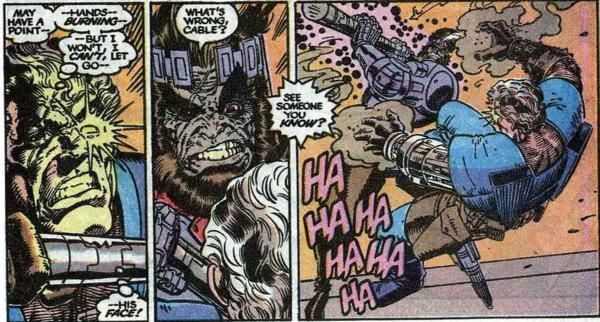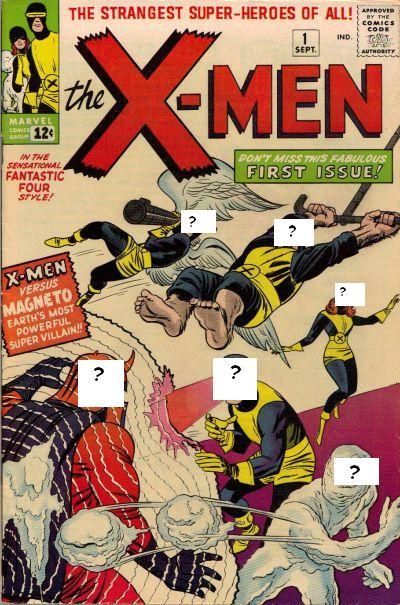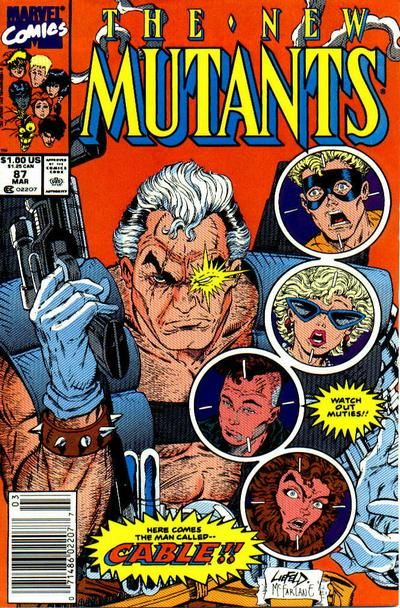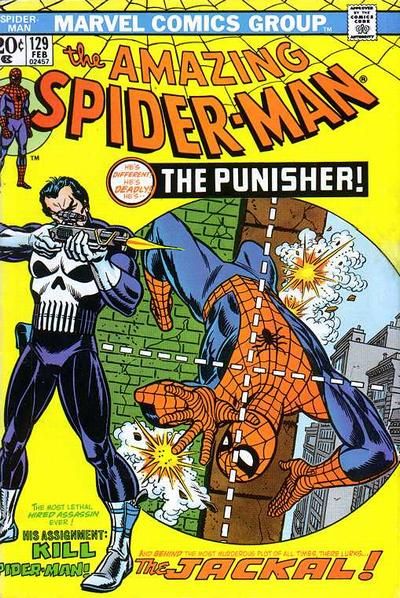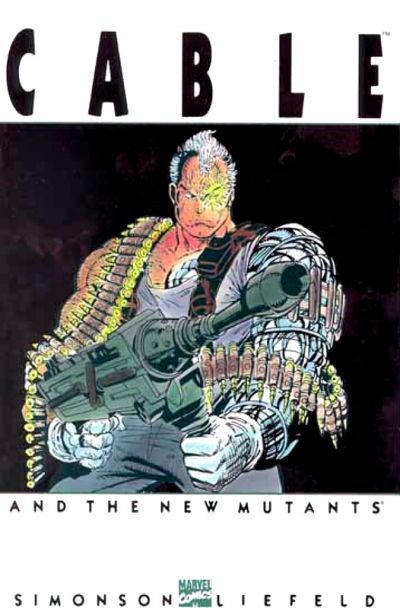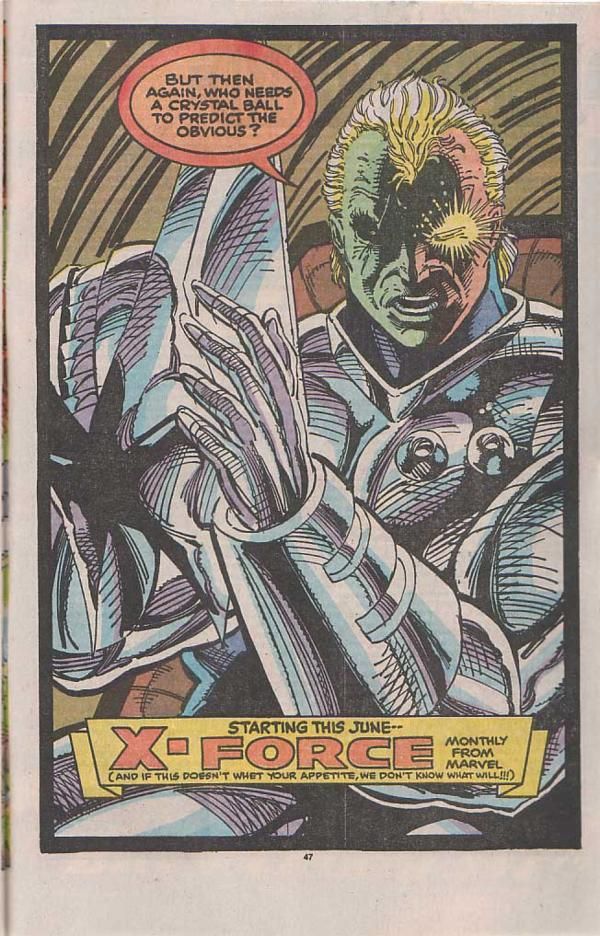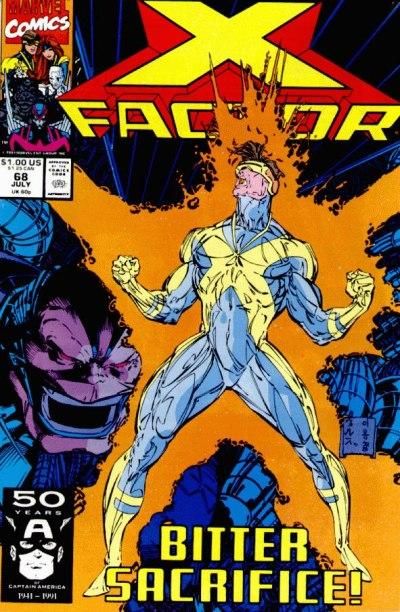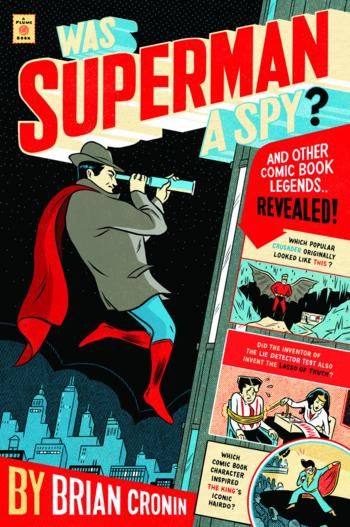This is the two-hundred and first in a series of examinations of comic book legends and whether they are true or false. Click here for an archive of the previous two hundred.
I'm taking a special approach to the column this week, with a special "What's the deal with Cable's origin(s)?" theme week.
Let's begin!
I noticed over the years that I have collected a great deal of various questions involving the creation and development of the character Cable. And since answering ONE of these questions is often, in effect, answering all the OTHERS, I've decided to just devote one full column just to questions about Cable and answer them all at once!
COMIC LEGEND: One of the names suggested for Cable before he debuted in New Mutants was Commander-X.
STATUS: More or Less True
COMIC LEGEND: Louise Simonson co-created Cable.
STATUS: Depends on whether Ross Andru co-created the Punisher (I'm leaning towards False on both counts).
COMIC LEGEND: Cable was originally intended to be Ahab.
STATUS: False
COMIC LEGEND: Cable was originally intended to be Nathan Summers.
STATUS: False
COMIC LEGEND: Stryfe was originally a mystery to everyone, the creative team included.
STATUS: True
COMIC LEGEND: At one point, Cable was intended to be Stryfe!
STATUS: True.
When you look at the history of most of the most famous comic book characters, their introductory story very often also includes a basic origin for the character. Whether it be just a panel mention (Superman) or a whole story devoted to the character's origin (Flash, Green Lantern, Fantastic Four, Spider-Man), either way, you have a good idea of the character's origin by the time the character has been established (Batman is a notable exception - there all we got was "socialite dresses up as Bat to fight crime").
This is not always the case, though, and it especially seemed to not be something that was not often the case when it came to the X-Men. In X-Men #1, the reader knows little about the origins of Cyclops, Iceman, Beast, Angel, Marvel Girl and particularly the villain Magneto (as I noted awhile back in one of my Cool Comic Book Moments, it would be years before we would ever see Magneto's FACE, let alone an origin for the guy!).
As time went by, this became a bit of a theme for the X-Men, particularly its most famous member, Wolverine. While Len Wein might have had an origin in mind for the character, it did not translate to the page and Wolverine did not have a proper origin for decades. Another popular character without an origin for a long time was Rogue. Chris Claremont soon became well known for adding a great deal of mystery to his characters, and it might very well be a major factor in the great success of the X-Men.
So when Cable was introduced in 1990, the only thing really locked down about the guy was that he was a time traveler from the future (and even that was not shown in the actual comics for some time). And since that was the only thing locked down, he ended up going through a great deal of changes over the years on the way to his "definitive" origin.
But before we even get that far, we should look at the behind the scenes "origin" of the character.
An interesting discussion can be made as to who is the "creator" of a comic book character under particular circumstances. In many ways, people tend to lean towards "whoever the first people to write and draw a character in a comic, they're the creator" as a rule. However, we know such a rule is not always true, as Chris Claremont and John Byrne, for instance, had nothing to do with the creation of Dazzler (as discussed in this installment of Comic Book Legends Revealed), yet Uncanny X-Men #130 was the first printed appearance of the character, and it was written and drawn by Claremont and Byrne.
If you then do not agree that "whoever first wrote and drew the character in a comic is the creator" (and I think that's the better way to look at it), then things obviously get a lot trickier.
Ross Andru is generally credited as one of the co-creators of the Punisher, along with Gerry Conway and John Romita, Sr. I believe that's how it is on Punisher's wikipedia page, for instance. However, Conway came up with the character (and yes, you can certainly snarkily dispute that if you're a Mack Bolan fan) and John Romita, Sr. designed the character (based on sketches by Conway). Ross Andru was the first person to draw the Punisher in a comic book. Is Ross Andru a co-creator of the Punisher?
Your answer to that question would inform your opinion as to what Louise Simonson's role in the creation of Cable was.
The genesis of the character came generally from editor Bob Harras determining that the New Mutants needed to shake things up, and what Harras wanted was a new leader for the group, someone a lot different than Professor X.
The book's writer at the time, Simonson, knew of this desire by Harras, and her thoughts on the subject instantly went towards the idea of a military leader.
At the same time, Harras separately went to the book's new artist, Rob Liefeld. Tasked with the idea of coming up with a new leader for the team (and perhaps even with the suggestion by Harras of "a bionic eye might look cool"), Liefeld began consulting his sketchebook.
You see, Liefeld already was brimming with ideas for the book, and his initial sketches for the New Mutants included a great many brand new characters, including one that never even made it into the book (as seen in this previous installment of Comic Book Legends Revealed).
One of his sketches was for a character with a bionic eye who Liefeld could see as the new leader of the New Mutants, a time traveling soldier from the future. Note that Simonson also was thinking about a time traveler when she was thinking about the pitch for the character.
Harras approved these sketches, and the character was to be added to the book.
Various names were discussed - Harras suggested either Quinn or Quentin (most likely the former, but the latter has been reported, as well), Liefeld initially had the name "Cyber" on the sketches and Simonson, while writing the scripts for his first appearance referred to the character as Commander-X (Simonson later pointed out that she was using the name "Commander-X" merely as a placeholder until an official name was chosen - Liefeld did not know this, though, so when he read the script, he thought that Simonson planned on using the name Commander-X). Liefeld eventually suggested calling the character Cable. That's, of course, the name that ended up being used.
Okay, so Liefeld came up with the design of the character and the name of the character. When Cable made his first appearance in New Mutants #87, the story was written by Simonson and drawn by Liefeld.
Does that make Simonson the co-creator of Cable, by being the first person to write the character in a comic? She, too, was thinking of a militaristic leader for the X-Men, but she was not working with Liefeld on the concept. She also was thinking about a time traveler. Liefeld, though, was so clearly influenced by the Terminator in his Cable designs that I tend to believe him when he says he intended the character as being a time traveler, as well. So while I have no doubt that Simonson came up with that idea on her own, I also believe Liefeld was coming to that same place on his own.
I lean towards crediting LIefeld and, to a certain extent, Harras, as the creators of Cable, but again, it depends on how you view these things (and it would also dramatically change things if Simonson was the one who told Liefeld that Cable was a time traveler - that is a major part of his characterization).
Stryfe, the arch-enemy of Cable, also debuted in the same issue of New Mutants as Cable. Again, Stryfe was from that same set of sketches by Liefeld as Cable (as was most of the Mutant Liberation Front that Sryfe led).
While Cable had the general "time traveler from the future" thing down, Stryfe was even MORE mysterious, and even more up in the air. Really, the creators were totally unsure of Stryfe's origins. In fact, one idea Liefeld had was that, for a major twist, it would be revealed that Stryfe was really a woman under all that armor.
However, ultimately it was determined by Liefeld that Stryfe would BE Cable! That was the big revelation at the end of New Mutants #100.
Liefeld's theory was that since Cable was a time-traveler, who knows "when" we are seeing Cable in HIS timeline. So we would then see him slowly descend into madness and become the nemesis of his own, younger self. It's a clever approach.
That particular approach was sidetracked (not totally thrown off, but sidetracked, at least) when Liefeld learned that Bob Harras, along with Whilce Portacio and Jim Lee, had determined Cable's origin on their own, apart from Liefeld, the creator of the character.
Harras, Portacio and Lee had come up with the idea that Nathan Summers, son of Cyclops and Madelyne Pryor, was going to be sent to the future and he would grow up to be Cable.
Liefeld did not like this idea at all, but he was stuck with it. He and Fabian Nicieza (who by that point had become the new scripter/co-writer on New Mutants with Liefeld) determined that, okay, the whole Stryfe as Cable thing could still work under this change, it would just be that Cable was a CLONE of Nathan Summers and Stryfe was Nathan Summers.
Ultimately, that would be turned down, but not definitively for quite some time (see this installment of Comic Book Legends Revealed to see how long it took before even THAT part of Cable's origin was nailed down). When Cable's origin finally saw print, he was, indeed, the original Nathan Summers and Stryfe was a clone. And that is the status quo still today.
Okay, what does that leave?
I guess that just leaves Ahab.
Ahab was a bad guy who was also from the future, and in a crossover storyline in the 1990 Annuals of Uncanny X-Men, X-Factor, New Mutants and the Fantastic Four, Ahab meets Cable and the following takes place...
So, was Ahab ever intended to be Cable?
No.
First off, that issue was written by Claremont, who really had no dealings with Cable. Secondly, as Fabian Nicieza has confirmed in an interview since, that was just an idea by Harras that Harras thought would be interesting, so he had it added to the story last-minute, just to throw some more uncertainty out there for the fans (as a red herring, of sorts). It was never intended to be anything but that.
I believe that's just about that. If there's any more Cable questions, I'll gladly add to this, but I think that really is all there is.
EDITED TO ADD: I see that there ARE some questions still! Reader Carl says:
Gee, I’d always heard Cable was supposed be the future self of Cannonball.
Honestly, Carl, that might very well have been something Liefeld considered at one point or another. Like I said above, besides "time traveler from the future," not a lot was set in stone with regards to Cable's origin (except that Liefeld did not think he was Nathan Summers), so I could certainly see it as a real possibility that Liefeld once considered that. I've never seen him specifically comment on it, though. However, what we CAN say is that Louise Simonson never intended that for Cable, as she apparently was rumored to at one point. Liefeld might have at one point or another, but Simonson never intended for Cable to be an older version of Cannonball.
Okay, again, any more Cable question, I'll gladly work them in!
Thanks to various interviews by various folks over the years for the information provided here (Fabian Nicieza, in particular - what's really amazing to me is how actually CONSISTENT most of the recollections are - it's surprising how, say, everyone concedes that yes, Liefeld sketched out Cable first), but the number one resource by far was Rob Liefeld, who was beautifully detailed on the origins of Cable in a column he used to write called "Robservations." In one of the installments of said column (about six-seven years ago), he went behind the scenes with Cable, and I'm extremely grateful for the insight. Thanks to reader Baron Von Glazer for telling me about Simonson's intentions vis a vis the name "Commander X" and thanks to my pal, Justin, for supplying what name was on the initial sketches of Cable. Also, thanks to all the various readers who have asked me Cable questions over the years - too many to name them all!
Okay, that's it for this week!
Thanks to the Grand Comic Book Database for this week's covers!
Feel free (heck, I implore you!) to write in with your suggestions for future installments! My e-mail address is cronb01@aol.com.
As you hopefully know by now, Plume Books (a division of Penguin Books) is publishing a collection of my Comic Book Legends Revealed columns (half expanded "best of"/half new stuff) and it is due out on April 28th.
Here is the cover by artist Mickey Duzyj. I think he did a very nice job (click to enlarge)...
If you'd like to pre-order it, you can use the following code if you'd like to send me a bit of a referral fee...
Was Superman a Spy?: And Other Comic Book Legends Revealed
See you next week!

